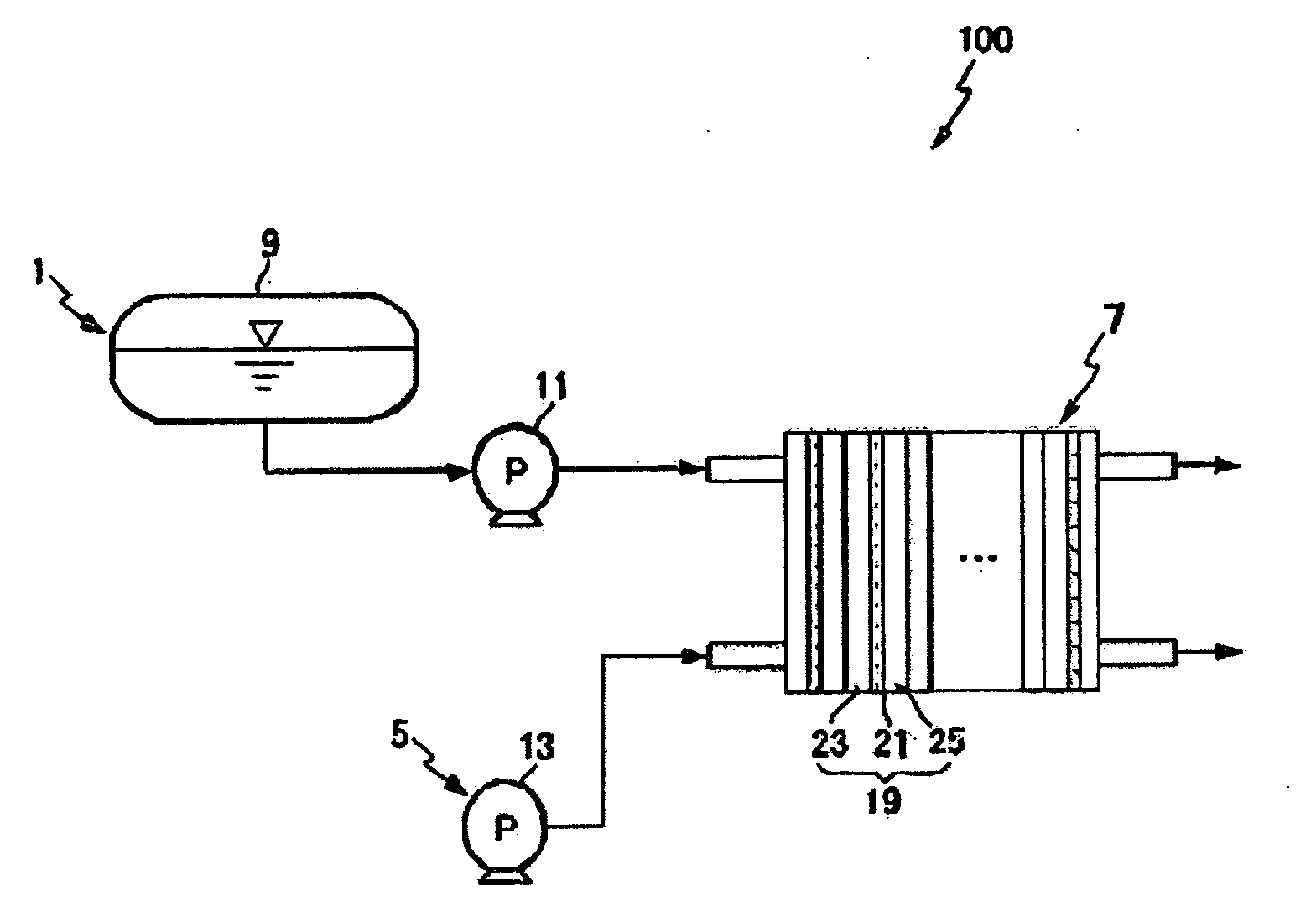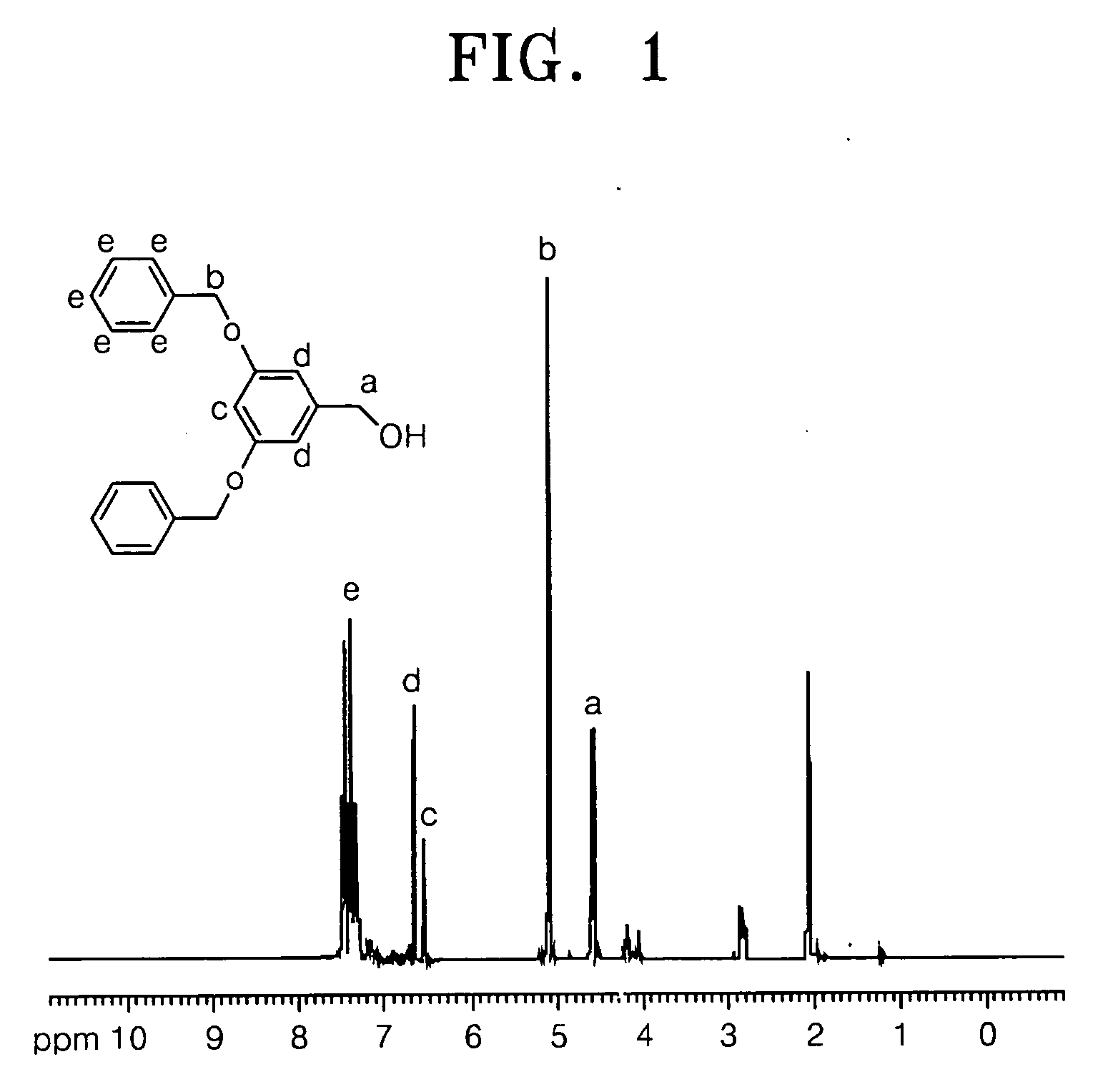Oligomer solid acid and polymer electrolyte membrane including the same
a polymer electrolyte and solid acid technology, applied in the direction of conductive materials, non-aqueous electrolytes, chemical/physical processes, etc., can solve the problems of significant decline in the performance drop in the electric potential of the cathode, and the inability to stabilize the nafionTM membrane under the operating conditions of the fuel cell, etc., to achieve excellent ionic conductivity and low methanol crossover
- Summary
- Abstract
- Description
- Claims
- Application Information
AI Technical Summary
Benefits of technology
Problems solved by technology
Method used
Image
Examples
example 1
[0061] 0.38 moles of benzyl bromide, 0.18 moles of 3,5-Dihydroxy benzyl alcohol, 0.36 moles of K2CO3 and 0.036 moles of 18-crown-6 were dissolved in acetone and refluxed at 60° C. for 24 hours. The mixture was cooled to room temperature. Then the acetone was removed by distillation and was extracted using an ethylacetate / sodium hydroxide solution to separate an organic layer from the mixture. The separated organic layer was dried using MgSO4 and the solvent was distilled and removed. The resulting product was recrystallized with ether / hexane and refined to obtain 37 g of the compound in Formula 19 as a white crystalline solid (Yield: 67%). The structure of compound in Formula 19 was identified using Nuclear Magnetic Resonance (NMR) analysis, and the results are shown in FIG. 1.
20 g (0.065 moles) of the compound of Formula 19 was dissolved in 50 ml of benzene at 0° C., and then a solution in which 6.4 g (0.0238 moles) of PBr3 was dissolved in benzene was added dropwise to the resu...
example 2
[0062] 100 parts by weight of the polymer matrix of Formula 16 manufactured as illustrated in Reaction Scheme 3 with the ratio of m to n being 5:5, and 6.7 parts by weight of the oligomer solid acid of Formula 23 were completely dissolved in N-methyl pyrrolidone (NMP) and casted at 110° C. to manufacture a polymer electrolyte membrane.
example 3
[0063] A polymer electrolyte membrane was manufactured according to Example 2, except that 10 parts by weight of the oligomer solid acid in Formula 23 was used.
[0064] The ionic conductivity and methanol crossover were respectively measured for the polymer electrolyte membranes manufactured as in Examples 2 and 3 and a polymer membrane in which a solid acid was not included. The results are illustrated in Table 1.
TABLE 1Methanol crossoverIonic conductivity (S / cm)(cm2 / sec)Polymer membrane2.60 × 10−62.73 × 10−9Example 21.48 × 10−4 (after 1 day)5.51 × 10−8Example 36.68 × 10−4 (after 1 day)4.63 × 10−8
PUM
| Property | Measurement | Unit |
|---|---|---|
| oligomer solid acid | aaaaa | aaaaa |
| degree of polymerization | aaaaa | aaaaa |
| swelling | aaaaa | aaaaa |
Abstract
Description
Claims
Application Information
 Login to View More
Login to View More - R&D
- Intellectual Property
- Life Sciences
- Materials
- Tech Scout
- Unparalleled Data Quality
- Higher Quality Content
- 60% Fewer Hallucinations
Browse by: Latest US Patents, China's latest patents, Technical Efficacy Thesaurus, Application Domain, Technology Topic, Popular Technical Reports.
© 2025 PatSnap. All rights reserved.Legal|Privacy policy|Modern Slavery Act Transparency Statement|Sitemap|About US| Contact US: help@patsnap.com



